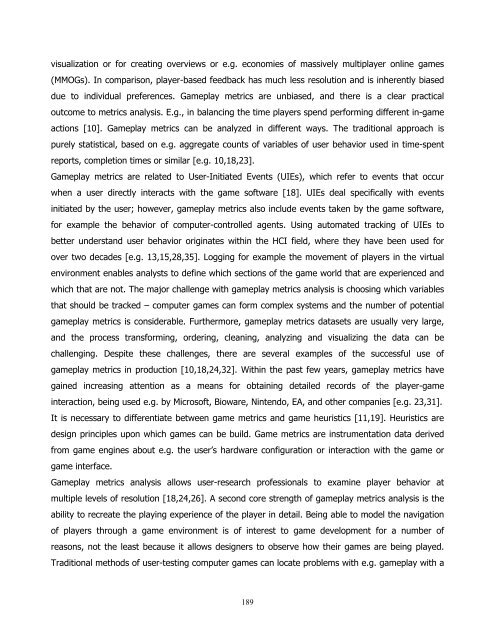Play-Persona: Modeling Player Behaviour in Computer Games
Play-Persona: Modeling Player Behaviour in Computer Games
Play-Persona: Modeling Player Behaviour in Computer Games
Create successful ePaper yourself
Turn your PDF publications into a flip-book with our unique Google optimized e-Paper software.
visualization or for creat<strong>in</strong>g overviews or e.g. economies of massively multiplayer onl<strong>in</strong>e games<br />
(MMOGs). In comparison, player-based feedback has much less resolution and is <strong>in</strong>herently biased<br />
due to <strong>in</strong>dividual preferences. Gameplay metrics are unbiased, and there is a clear practical<br />
outcome to metrics analysis. E.g., <strong>in</strong> balanc<strong>in</strong>g the time players spend perform<strong>in</strong>g different <strong>in</strong>-game<br />
actions [10]. Gameplay metrics can be analyzed <strong>in</strong> different ways. The traditional approach is<br />
purely statistical, based on e.g. aggregate counts of variables of user behavior used <strong>in</strong> time-spent<br />
reports, completion times or similar [e.g. 10,18,23].<br />
Gameplay metrics are related to User-Initiated Events (UIEs), which refer to events that occur<br />
when a user directly <strong>in</strong>teracts with the game software [18]. UIEs deal specifically with events<br />
<strong>in</strong>itiated by the user; however, gameplay metrics also <strong>in</strong>clude events taken by the game software,<br />
for example the behavior of computer-controlled agents. Us<strong>in</strong>g automated track<strong>in</strong>g of UIEs to<br />
better understand user behavior orig<strong>in</strong>ates with<strong>in</strong> the HCI field, where they have been used for<br />
over two decades [e.g. 13,15,28,35]. Logg<strong>in</strong>g for example the movement of players <strong>in</strong> the virtual<br />
environment enables analysts to def<strong>in</strong>e which sections of the game world that are experienced and<br />
which that are not. The major challenge with gameplay metrics analysis is choos<strong>in</strong>g which variables<br />
that should be tracked – computer games can form complex systems and the number of potential<br />
gameplay metrics is considerable. Furthermore, gameplay metrics datasets are usually very large,<br />
and the process transform<strong>in</strong>g, order<strong>in</strong>g, clean<strong>in</strong>g, analyz<strong>in</strong>g and visualiz<strong>in</strong>g the data can be<br />
challeng<strong>in</strong>g. Despite these challenges, there are several examples of the successful use of<br />
gameplay metrics <strong>in</strong> production [10,18,24,32]. With<strong>in</strong> the past few years, gameplay metrics have<br />
ga<strong>in</strong>ed <strong>in</strong>creas<strong>in</strong>g attention as a means for obta<strong>in</strong><strong>in</strong>g detailed records of the player-game<br />
<strong>in</strong>teraction, be<strong>in</strong>g used e.g. by Microsoft, Bioware, N<strong>in</strong>tendo, EA, and other companies [e.g. 23,31].<br />
It is necessary to differentiate between game metrics and game heuristics [11,19]. Heuristics are<br />
design pr<strong>in</strong>ciples upon which games can be build. Game metrics are <strong>in</strong>strumentation data derived<br />
from game eng<strong>in</strong>es about e.g. the user’s hardware configuration or <strong>in</strong>teraction with the game or<br />
game <strong>in</strong>terface.<br />
Gameplay metrics analysis allows user-research professionals to exam<strong>in</strong>e player behavior at<br />
multiple levels of resolution [18,24,26]. A second core strength of gameplay metrics analysis is the<br />
ability to recreate the play<strong>in</strong>g experience of the player <strong>in</strong> detail. Be<strong>in</strong>g able to model the navigation<br />
of players through a game environment is of <strong>in</strong>terest to game development for a number of<br />
reasons, not the least because it allows designers to observe how their games are be<strong>in</strong>g played.<br />
Traditional methods of user-test<strong>in</strong>g computer games can locate problems with e.g. gameplay with a<br />
189















